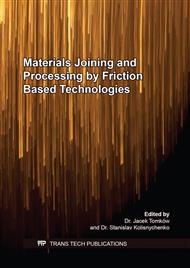[1]
Li. Y. Murr, L. E., and McClure, J. C. J,Solid-state flow visualization in the friction-stir welding of 2024 Al to 6061 Al,, Scripta materialia, 40(9) (1999)1041-1046.
DOI: 10.1016/s1359-6462(99)00062-7
Google Scholar
[2]
K. Colligan, Material flow behaviour during friction welding of aluminum,, Weld J, 78(7) (1999) 229-237.
Google Scholar
[3]
G. Cui, Z. Ma and S. Li, Periodical plastic flow pattern in friction stir processed Al–Mg alloy,, Scripta Materialia, 58(12) (2008)1082-1085.
DOI: 10.1016/j.scriptamat.2008.02.003
Google Scholar
[4]
A.P Reynolds, Flow visualization and simulation in FSW,, Scripta materialia,58(5) (2008) 338-342.
DOI: 10.1016/j.scriptamat.2007.10.048
Google Scholar
[5]
A.P Reynolds,Visualisation of material flow in autogenous friction stir welds,, Science and Technology of Welding Joining, 5(2) (2000) 5.
DOI: 10.1179/136217100101538119
Google Scholar
[6]
T. U. Seidel and A. P. Reynolds ,Visualization of the Material Flow in AA2195 Friction-Stir Welds Using a Marker Insert Technique T.U,, Metallurgical and Materials Transactions A, 32(11) (2001) 2879-2884.
DOI: 10.1007/s11661-001-1038-1
Google Scholar
[7]
J. Schneider and A. N. Jr, Thermo-mechanical processing in friction stir welds,(2002) 43-51.
Google Scholar
[8]
F.Gratecap, M. Girard, S. Marya and G Racineux, Exploring material flow in friction stir welding : Tool eccentricity and formation of banded structures,,journal of material forming, 5(2) (2011) 99-107.
DOI: 10.1007/s12289-010-1008-5
Google Scholar
[9]
P. Heurtier, M. Jones and C. Desrayaud, Mechanical and thermal modelling of friction stir welding,,Journal of Materials , 171(3) (2006)348-357.
DOI: 10.1016/j.jmatprotec.2005.07.014
Google Scholar
[10]
Y. S. Sato, H. Takauchi, S. H. C. Park and H. Kokawa, Characteristics of the kissing-bond in friction stir welded Al alloy 1050,, Materials Science and Engineering. A, 405(1-2) (2005) 333–338.
DOI: 10.1016/j.msea.2005.06.008
Google Scholar
[11]
S. Xu and X. Deng, A study of texture patterns in friction stir welds,, Acta Materialia. 56. (2008)1326-1341.
DOI: 10.1016/j.actamat.2007.11.016
Google Scholar
[12]
Z. Zhang, B. Xiao and Z. Ma, Effect of Segregation of Secondary Phase Particles and "S" Line on Tensile Fracture Behavior of Friction Stir-Welded 2024Al-T351 Joints,, Metal lurgical and Materials Transactions A. (2013).
DOI: 10.1007/s11661-013-1778-8
Google Scholar
[13]
L. Ye. Rim, No. Kookil, Y. Jong-Hoon, Y. Joon-Tae and L. Ho-Sung, Investigation of Microstructure in Friction Stir Welded Al-Cu-Li alloy,,Key Engineering Materials, 705 (2016) 240-244.
DOI: 10.4028/www.scientific.net/kem.705.240
Google Scholar
[14]
F.C. Liu and T.W. Nelson, In-situmaterial flow pattern around probe during friction stir welding of austenitic stainless steel,, Materials and Design, 110 (2016) 354–364.
DOI: 10.1016/j.matdes.2016.07.147
Google Scholar
[15]
R. Kumar, V. Pancholi and R.P. Bharti, Material flow visualization and determination of strain rate during friction stir welding,, Journal of Materials Processing Tech, 255 (2018) 470–476.
DOI: 10.1016/j.jmatprotec.2017.12.034
Google Scholar
[16]
X.C. Liu and C.S.Wu,Material flow in ultrasonic vibration enhanced friction stir welding,, Journal of Materials Processing Technology, 225 (2015) 32–44.
DOI: 10.1016/j.jmatprotec.2015.05.020
Google Scholar
[17]
E. Hoyos, D. López and H. Alvarez, A phenomenologically basedmaterial flowmodel for friction stirwelding,, Materials and Design, 111 (2016) 321–330.
DOI: 10.1016/j.matdes.2016.09.009
Google Scholar
[18]
E. Feulvarche, Modélisation numérique du soudage par friction malaxage,, Thèse de doctorat, Université Jean Monnet de Saint-Etienne.,(2005).
DOI: 10.51257/a-v3-bm7764
Google Scholar
[19]
A. Bastier, Modélisation du soudage d'alliages d'aluminium par friction et malaxage ,, Thèse de doctorat, Ecole polytechnique. (2006).
Google Scholar
[20]
A. Guedoiri, Contribution à la modelisation et à la simulation numérique du soudage par friction et malaxage, Thèse de doctorat, Arts et Métiers ParisTech. (2012).
DOI: 10.1522/030333805
Google Scholar
[21]
T. Heuzé, Modélisation des couplages fluide /solide dans les procédés d'assemblage à haute température,, Thèse de doctorat, Université Pierre et Marie Curie. (2011).
DOI: 10.1051/meca/2011113
Google Scholar
[22]
R. Brun, and N. Belouaggadia, Ecoulement et transferts fluide parfaits, fluids réels, convection,, Ellipses, (2011).
Google Scholar



